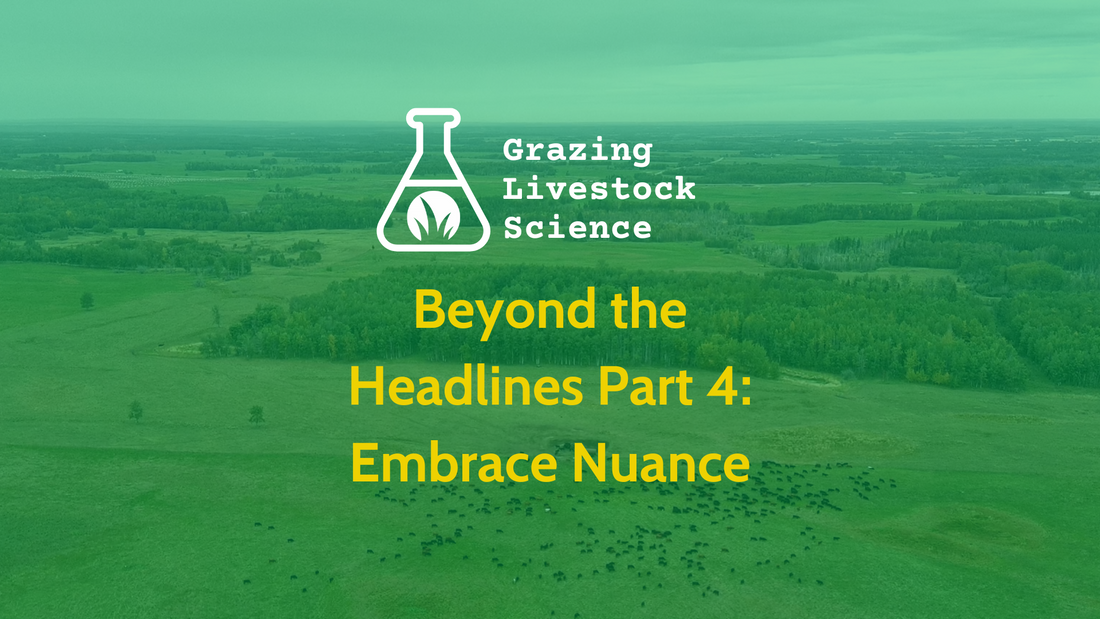
Beyond the Headlines Part 4: Embrace Nuance
Throughout our series on sustainable livestock agriculture, we've explored three key areas where the environmental conversation about meat production often misses important nuances:
- How methane from cattle behaves differently in the atmosphere than carbon dioxide
- Why assessing nutritional value and co-products matters in environmental footprinting
- How livestock can positively interact with land, water, and biodiversity
Now, let's tie these insights together and explore how Modern Pastures is putting these principles into practice as we work to transform our food system.
The Problem with Single Metrics
Perhaps the most consistent theme across our series has been that relying on single, simplified metrics rarely tells the full story of livestock's environmental impact. Whether it's using GWP₁₀₀ to assess methane without accounting for its shorter atmospheric lifespan, measuring environmental impact per kilogram without considering nutrition, or calculating water footprints without differentiating between rainfall and irrigation—simplified metrics can lead to misleading conclusions.
The reality is that environmental assessment is inherently complex, and no single number can adequately capture all the relevant factors. As the research paper we've been exploring puts it: "The complexity of environmental impact accounting typically leads to over-simplistic use of an impact metric, e.g., CO₂-eq/kg product or unit of protein/energy, which does not represent the true impact and value of livestock products."
A More Balanced Approach
Instead of relying on oversimplified metrics, a more comprehensive assessment of livestock's environmental impact would include:
1. Appropriate Climate Metrics
Using metrics like GWP* that better account for the different atmospheric behaviors of greenhouse gases, particularly methane's shorter lifespan. This provides a more accurate picture of livestock's climate impact and the significant benefits of even small methane reductions.
2. Nutritional Value Considerations
Evaluating environmental impact in relation to complete nutritional profiles, including protein quality, micronutrient content, and bioavailability. This nutritional lens provides a more accurate picture of food's value relative to its environmental cost.
3. Full Accounting of Co-Products
Properly allocating environmental impacts across all the products and services that come from livestock, not just edible meat. This includes everything from leather and pharmaceuticals to ecosystem services and cultural value.
4. Context-Specific Assessment
Recognizing that production methods and regional contexts matter tremendously. The environmental impact of livestock varies dramatically depending on how and where animals are raised.
5. Consideration of Alternatives
Accounting for what would happen in alternative scenarios without livestock, including potential increases in wild ruminants, termites, or wildfire emissions. These "background emissions" are often overlooked in simplistic assessments.
6. Biodiversity and Ecosystem Function
Evaluating impacts on overall ecosystem health and biodiversity, not just single metrics like greenhouse gas emissions. Well-managed livestock can enhance rather than degrade ecosystems.
When we apply this more balanced approach, the narrative around livestock often changes significantly. While there are certainly production systems with substantial negative impacts, there are also many that provide nutritious food while maintaining or even improving ecological health.
The Modern Pastures Approach
At Modern Pastures, our vision is "a food system where land-restoring farming practices are the norm, where farmers thrive while improving soil health and ecosystem function, where consumers understand and value how their food is produced, and where direct relationships between producers and consumers create resilient local food networks that benefit all."
Here's how we're putting the principles from this series into practice:
1. Partnering with Land-Enhancing Producers
Our cornerstone partner, Meunier Livestock Ltd., represents a 125-year agricultural legacy that has focused intensively on soil health and ecosystem function for over 20 years. Through persistent rotational grazing management, they've transformed their land's productivity, soil quality, and resilience to drought and wildfire.
Their mission—"Thriving plants, animals, and people"—aligns perfectly with our vision of a regenerative food system that benefits all participants, from soil microbes to the end consumer.
2. Focusing on Complete Nutrition
We recognize that our products aren't just sources of calories or protein—they're complete nutritional packages that support human health. We focus on optimizing our production and finishing methods to enhance the nutritional profile of our meats, delivering maximum nutritional value per environmental impact.
3. Embracing Transparency
We believe consumers deserve to know not just what they're eating, but how it was produced. That's why we're committed to transparent communication about our farming practices and food production methods. This transparency helps rebuild the vital connection between consumers and their food source—a connection that's been largely lost as Canada has urbanized from 32% of the population living on farms 80 years ago to just 1.6% today.
4. Taking a Balanced View
We embrace a balanced, evidence-based approach rather than relying on marketing buzzwords or fear-based messaging. For example, we recognize that when done properly, grain finishing can result in lower carbon and ecological footprints while producing excellent eating quality. We make decisions based on science and practical farming experience rather than following marketing trends.
5. Continuous Improvement
We're committed to continuously improving our environmental performance and the nutritional quality of our products. The next phase of our optimization involves incorporating more ecological farming methods into the finishing phase of cattle production, building upon animal health and welfare while enhancing the nutritional density of the final meat product.
6. Building Direct Relationships
By connecting consumers directly with their food producers, we're creating resilient local food networks that can better withstand economic, environmental, and social challenges. These direct relationships also allow for more transparency and trust in the food system.
The Consumer's Role
As a conscientious consumer, you play a crucial role in supporting this more balanced approach to livestock agriculture:
- Look beyond simplified claims: When you see environmental claims about food, consider whether they're accounting for the full picture or just using simplified metrics.
- Value nutrition, not just calories: Consider the complete nutritional profile of foods, including micronutrients and bioavailability, not just calorie or protein content.
- Support transparent producers: Choose brands and farms that are open about their production methods and environmental impacts.
- Consider context: Recognize that how and where food is produced matters as much as what type of food it is.
- Embrace complexity: Be wary of black-and-white claims about food's environmental impact. The reality is usually more nuanced.
By choosing Modern Pastures products, you're supporting a food system that works with natural processes rather than against them, that values the land and the people who tend it, and that recognizes the complex but vital role of livestock in sustainable agriculture.
A Path Forward
The path to a truly sustainable food system isn't about eliminating entire food categories based on oversimplified metrics. Instead, it's about improving practices across all agriculture, leveraging the unique benefits of different production systems in appropriate contexts, and ensuring transparency so consumers can make informed choices.
As the research paper we've been exploring concludes: "Yes, the challenges of reducing GHGs are relevant to all sectors including livestock, but balanced burden attribution needs to be applied to ensure the outcome is not perverse when considering the needs for feeding a growing population and the value livestock so clearly provides."
Modern Pastures: Building a Better Food System
At Modern Pastures, we're committed to expanding our model by adding more brands that leverage our infrastructure. Starting with our beef brand from Meunier Livestock, we plan to add two more beef brands, two lamb brands, and a bison brand in 2025.
Our initial focus on frozen meat and shelf-stable products represents a zero-waste strategy that brings value to customers. We're also developing naturally processed meat products like beef dogs, jerky, and meat snacks to add convenience for customers seeking ready-to-eat and shelf-stable healthy options.
This approach aligns perfectly with our core identity: connecting conscientious consumers with premium meat products from farms that improve the land by raising animals, preserving agricultural heritage while advancing sustainable food systems through direct farm-to-consumer relationships.
Whether you're seeking high-quality, nutrient-dense foods, a foodie looking for exceptional eating experiences, an environmentally concerned consumer researching sustainable food choices, or an urbanite maintaining your connection to agricultural traditions—Modern Pastures offers a way to enjoy meat that aligns with your values.
By supporting direct farm purchases through Modern Pastures, you're not just buying superior meat products—you're contributing to better production methods and helping maintain the vital connection between people, food, and the natural systems that sustain us all.
We invite you to join us on this journey toward a more balanced, transparent, and sustainable food system. Because understanding the whole story matters, not just the headlines.
Modern Pastures is a farm-direct meat company based in Western Canada, in a region perfectly suited for grazing beef and other ruminants.
The article that was the primary source for this series can be found at https://doi.org/10.1093/af/vfac096
